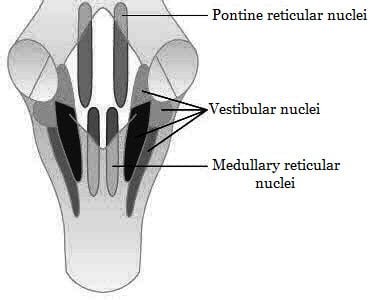TABLE OF CONTENTS
Medulla oblongata and Pons
Medulla oblongata
Medulla oblongata is located in the top of the spinal cord. Has centres that control reflectes activities such as respiration, heart rate, vasodilation and blood pressure.
Houses neural part ways that connect cerebral cortex and spinal cord The cranial nerves glosso-pharyngeal (IX), vagus (x), spinal accessory (xi) and the hypoglossal (xii) originate from the medulla.
The nuclei gracilis‚ and cuneatus transmit the informations of the spinal cord to the somato sensory regions of the cerebral cortex through the thalamus.
The nucleus gracilis and cuneatus give rise to fibres, which pass to the contralateral side and form the medial lemniscus; this medial lemniscus ascends to thalamus.

The inferior olivary nucleus input signals to cerebellum. Within medulla there are centres for cardiac, respiratory (inspiratory and expiratory), vasomotor, swallowing, vomiting, cough and sneezing activities.
Most of the tracts between the spinal cord and the higher levels of the brain pass through medulla.
Ascending tracts
A portion of dorsal funiculus of the spinal cord terminates in accessory cuneate nucleus from which fibres project to cerebellum as external arcuate fibres. Other ascending fibre tracts of the medulla are spinothalamic, dorsal and ventral spinocerebellar, spino-olivary, spino-tectal tracts.
Descending tracts
includes Vestibulo spinal, rubro spinal, tecto spinal tracts.
Pons
Structures present above the medulla function as bridging and communicating information between medulla cerebellum and forebrain structures. Pons contain pontine nuclei.
It also includes superior olivary nucleus of auditory system and nuclei of visceral centres to regulates respiratory and cardio vascular system. It is concerned with control of alertness and initiates sleep.
Pons serves as integration centre and relay motor centres. It also houses cranial nerves 5,6,7 and 8. It has two paired respiratory centres known as pneumotaxic centre and apneustic centre that control respiratory rate and rhythm.